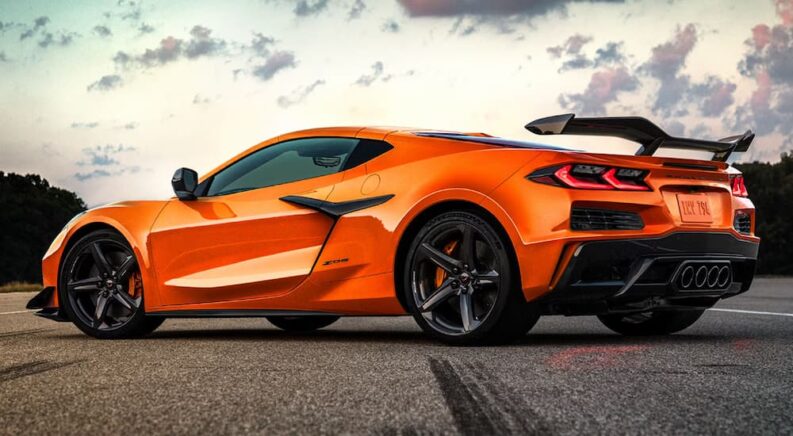There are moments in automotive history that stand out from the everyday evolution of vehicles: the addition of a front windscreen, seatbelts, the great big winged sedans of the 1950s, pony cars, off-road vehicles, very small coupes with amazing gas mileage, and hybrids. But for a brief moment in the late 1990s, right before the turn of the century, we experienced a moment in time that changed a lot of how we thought about our daily drivers.
The term that inspired this moment was simple: issued from the governing body of the FIA GT1. In 1997, the Fédération Internationale de l’Automobile redefined the Grand Touring classes to include only street-legal vehicles. While the vehicles entered in the races could be modified within certain restrictions, manufacturers needed to provide at least a 25-model production run in order to race. The rest, as they say, is automotive history. This rule change influenced an entire market of automobiles that were very fast, very cool, and very legal.
What Does “Street Legal” Really Mean?
In most cases, there’s a big thick line of disagreement between what the FIA GT1 regulations and state law considered “street legal” in 1997. In most states, cars and trucks must be equipped with basic necessities, such as two headlights, front and rear turn signals, brake lights, and, unless grandfathered in based on the age of the vehicle, seat belts for all passengers. Again, state laws vary, but in order to be legally driven on the streets, vehicles need to be registered with a current, valid license plate.
Per the FIA GT1 rulebook, Title Vll, “Sports Cars (Group 5)” Art. 267. Definition: high-performance cars which must nevertheless include all equipment normally provided and legally required for vehicles using public roads. Art. 268-Manufacturing continues with an explanation of the guidelines: 25 ex/year; minimum number of seats: 2.
This threw most auto manufacturers into an engineering quandary, and they quickly scrambled to create the fastest possible production cars in the smallest possible batches to meet these new regulations in time for the upcoming race season.

It’s GT Time: How GT1 Regulations Gave Us More Street Legal Race Cars
Flash forward to now. If we follow the lineage of the original street-legal GT1 racecars, we end up with today’s supercar. But let’s back up briefly, specifically to 1997 when this rule was established.
For some manufacturers, this rule change was beneficial, helping them to expand their luxury lineup to include very fast vehicles. For example, the Porsche 911 GT1 racecar immediately attracted the attention of regular road drivers. However, Porsche was unsure how to proceed. Initially, they toned down the engine, but customers wanted the full-throttle racecar experience.
The final product hit the public roadways in 1997. Known as the Straßenversion, this version of the Porsche 911 GT1 included a twin-turbocharged, intercooled DOHC 24-valve flat-6 engine that cranks out 536 hp and 442 lb-ft of torque. With a top speed of 193 mph and a 0 to 60 mile per hour time of just 3.6 seconds, drivers were happy to cough up the cash, often in the two-comma region, for a limited-run 911 GT1.
This same homologation rule also gave us the Mercedes-Benz CLK-GTR. A collaboration between Mercedes-Benz and AMG, the CLK-GTR is not just fast—it was created very quickly. From dream to driver’s seat, the CLK-GTR was conceptualized in just 128 days.
Of course, then Mercedes-Benz had to produce a street-legal limited run. They released 20 coupes and six open-top roadsters that would meet the ruling that race cars had to be based on a production vehicle. Again, that meant limiting the horsepower to meet local laws, but to call the Mercedes-Benz CLK-GTR Straßenversion a slow car would be a disservice.
Under the hood of the road versions of these street-legal racecars is a 6.9L V12 engine that calmly accelerates from 0 to 60 mph in a little over 3 seconds, thanks to a whopping 612 hp. Top speed is over 200 mph, though that part might not be exactly “street legal.” In fact, Mercedes-Benz specifically declined to make their Straßenversion compliant with US safety requirements, making any models that made it over here for show purposes only.
Where to Find a Street Legal Racer Today
For several decades, the only way to get a GT1 street-legal race car in the United States was to spend millions of dollars on the car and figure out how to have it legally imported. This is why you don’t see too many McLarens zipping down the interstate. However, more and more cars on American roadways meet the speed and power threshold that the GT cars of the 1990s established.
One such example is the 2025 Ford Mustang GTD. Using the catchphrase “Street Legal. But Just Barely,” the Mustang GTD is responsible for a 6 minute, 52.072 second Official Nürburgring Time, completing the 12.9-mile course faster than any other American production car. This is mostly thanks to the 815 hp supercharged 5.2L V8 engine under the hood, but this street-legal race car’s entire design is based on speed.
The GTD features technology that isn’t quite as common on today’s production cars. The Mustang GTD features a cutting-edge Multimatic DSSV suspension system, six-piston Brembo brakes in the front, and cooling front fender vents. By adding a Track Mode that lowers the vehicle by 40mm and an aero rear wing to direct downforce, the 2025 Mustang GTD makes Ford a serious contender in supercar territory.
Another beloved supercar on American streets is the Nissan GT-R NISMO. Though the last GT-R NISMO was produced in 2024, a legend is a legend. Every detail of the GT-R has been carefully considered and specially engineered by the team at Nissan, including the body design, the brakes, and even the Recaro body-bolstering seats to keep drivers focused on taming the specially-tuned 3.8-liter DOHC 24-valve twin-turbocharged V6 under the hood. After all, if you have over 600 horses, you need to take good care of them.
The list of special features that help the 2024 Nissan GT-R NISMO reach and sustain tremendous speeds reads like a dream shopping list: high-performance 1.5-way mechanical front and rear limited-slip differentials, dual-clutch 6-speed transmission, and double-wishbone front suspension with multi-link rear suspension, courtesy of Bilstein DampTronic.
From Street Legal to Supercars
While we can’t give the FIA full credit for inspiring a legacy of very fast cars that just barely meet the legal requirements for street use, they definitely hastened the process of supercar engine development. The Ford Mustang GTD and Nissan GT-R NISMO are just two examples of vehicles that owe their existence to the GT1 rules.
In fact, more and more American cars are developing production versions of their GT road cars. The production model of the Corvette Z06 GT3.R is a formidable Grand Touring car and meets the definition of supercar with its intense speeds. The Acura NSX GT3 recently celebrated eight successful years in the IMSA WeatherTech SportsCar Championship series with several handfuls of championship trophies to its name.
Had the FIA GT1 rules not changed 30 years ago, we might not have had the opportunity to have a street-legal race car in our garages. And while it’s hard to say that anyone needs one of these cars as a daily driver, it’s nice to think that the law is on your side if that dream happens to come true.





